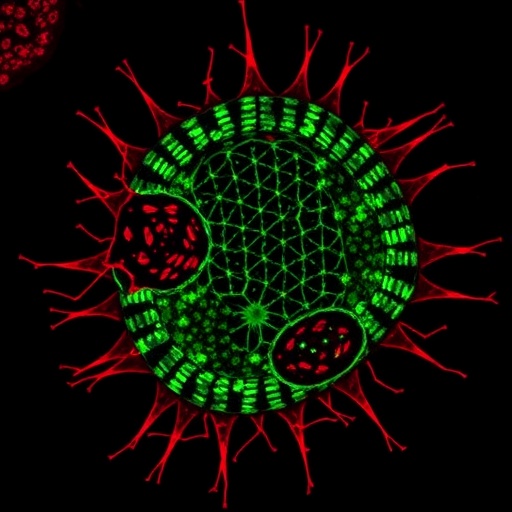In the relentless quest to uncover novel and effective cancer therapies, a groundbreaking study has emerged spotlighting the antineoplastic properties of pigments derived from the marine bacterium Kushneria avicenniae. This research, recently published in Medical Oncology, unveils how these bioactive pigments wield their anticancer capabilities by intricately modulating critical molecular pathways involved in cell survival and programmed cell death. The implications of these findings ripple across the landscapes of oncology and pharmacology, offering a promising avenue for the development of innovative treatments against formidable cancers such as liver and breast cancer.
The study zeroes in on the molecular intricacies underlying cancer cell fate, focusing on the delicate balance between pro-apoptotic and anti-apoptotic regulators, primarily the BAX/BCL-2 axis, alongside activation of the initiator caspase CASP-9. In cancerous cells, this equilibrium is often disrupted, leading to uncontrolled proliferation and evasion of apoptosis, a hallmark of malignancy. By harnessing the pigments from Kushneria avicenniae, researchers have demonstrated a robust capacity to recalibrate this balance, tipping it decisively towards apoptosis and consequently thwarting tumor progression.
Central to the study is the examination of how these pigments induce cell cycle arrest at the G2/M phase. The G2/M checkpoint plays a pivotal role in ensuring that cells do not proceed to mitosis with damaged DNA, thereby preserving genomic integrity. The enforced arrest at this juncture signifies a profound interruption in the cancer cells’ ability to divide and propagate. This blockade initiates a cascade of intracellular events that culminate in cell death, highlighting the potential of these pigments as targeted therapeutics that can halt tumor growth at a critical control point.
.adsslot_V4vI0pJNmR{ width:728px !important; height:90px !important; }
@media (max-width:1199px) { .adsslot_V4vI0pJNmR{ width:468px !important; height:60px !important; } }
@media (max-width:767px) { .adsslot_V4vI0pJNmR{ width:320px !important; height:50px !important; } }
ADVERTISEMENT
The dual focus on liver and breast cancer cell lines underscores the broad-spectrum potential of these microbial pigments. Liver cancer, often characterized by late diagnosis and limited therapeutic options, and breast cancer, a heterogeneous disease with complex resistance mechanisms, both represent critical domains where new interventions are urgently needed. The experimental data reveal significant cytotoxic effects manifested through enhanced apoptotic markers and tumor suppressor activities, paving the way for subsequent in vivo studies and clinical translation.
Delving deeper, the study elucidates the biochemical nature of the pigments extracted from Kushneria avicenniae, emphasizing their distinctive molecular architecture that underpins biological activity. Biopigments of microbial origin have surged to the forefront of cancer research due to their inherent antioxidant, anti-inflammatory, and now, antineoplastic properties. The structural configuration of these pigments facilitates interactions with cellular membranes and signaling proteins, thereby modulating intracellular pathways that govern survival and apoptosis.
Beyond the molecular canvas, the researchers have meticulously employed a battery of assays to characterize the functional impact of these pigments on cancer cells. Techniques ranging from flow cytometry to detect cell cycle distribution, Western blot analysis for protein expression levels, and caspase activity assays have collectively affixed credibility to the mechanistic claims. Such rigorous methodological approaches ensure a comprehensive understanding of how Kushneria avicenniae pigments exert their influence at the cellular level.
Moreover, insights gleaned from this investigation may enable the design of synergistic therapeutic strategies. The ability of these pigments to engage critical apoptotic pathways and cell cycle checkpoints suggests compatibility with existing chemotherapeutic or targeted agents, potentially enhancing treatment efficacy while mitigating adverse effects. This integrative approach aligns with precision medicine paradigms aimed at tailoring interventions to the molecular profiles of individual tumors.
The safety profile and selectivity of Kushneria avicenniae pigments remain pivotal considerations for their translational journey. Preliminary toxicity evaluations indicate a favorable therapeutic window, underscoring the pigments’ selective cytotoxicity towards malignant cells with minimal impact on normal counterparts. Such specificity is paramount in circumventing the systemic toxicities that plague conventional chemotherapy, offering hope for more tolerable cancer regimens.
From a molecular oncology vantage, the study revitalizes interest in modulating the intrinsic apoptotic pathway as a cornerstone for cancer treatment. While the exploitation of BCL-2 family proteins has been an established strategy, the adjunct use of natural pigments introduces an innovative angle, potentially overcoming resistance mechanisms that impair conventional drugs targeting these pathways. The activation of caspase-9 further consolidates this pro-apoptotic assault, orchestrating the cellular demise indispensable for cancer control.
Emerging from these findings is the broader implication that microbial pigments could serve as molecular scaffolds for drug development. Their inherent bioactivity coupled with modifiable chemical backbones allow medicinal chemists to engineer derivatives with optimized pharmacodynamics and pharmacokinetics. This confluence of natural product chemistry and synthetic innovation may accelerate the advent of next-generation anticancer therapeutics derived from marine microbiota.
The anticipation now pivots towards clinical validation, where the efficacy of these pigments can be assessed in animal models and eventually human trials. Such endeavors will require multidisciplinary collaboration encompassing pharmacology, oncology, and biotechnology to navigate challenges from compound stability to delivery mechanisms. The promise of Kushneria avicenniae pigments as powerful anticancer agents offers a beacon of hope against some of the most daunting malignancies affecting humanity.
In conclusion, this pioneering research not only enriches scientific understanding of marine bacterial pigments as bioactive compounds but also charts a promising course for novel anticancer therapeutics. By intricately manipulating key apoptotic regulators and cell cycle checkpoints, these pigments stand as testament to nature’s ingenuity in providing solutions to human health challenges. The oncology community keenly awaits subsequent developments that will translate these compelling molecular insights into tangible clinical benefits.
Subject of Research: Antineoplastic potential of Kushneria avicenniae pigments and their effect on apoptosis and cell cycle arrest in liver and breast cancer cells.
Article Title: Antineoplastic potential of Kushneria avicenniae pigments via modulation of the BAX/BCL-2 axis and CASP-9 pathway in inducing G2/M arrest and apoptosis in liver and breast cancer.
Article References:
Almetwaly, H., Elmetwalli, A., El-Amier, Y.A. et al. Antineoplastic potential of Kushneria avicenniae pigments via modulation of the BAX/BCL-2 axis and CASP-9 pathway in inducing G2/M arrest and apoptosis in liver and breast cancer. Med Oncol 42, 400 (2025). https://doi.org/10.1007/s12032-025-02949-1
Image Credits: AI Generated
Tags: antineoplastic properties of pigmentsBAX BCL-2 modulationbreast cancer innovative treatmentscancer cell apoptosis mechanismsCASP-9 activation in cancerG2/M cell cycle arrestKushneria avicenniae pigmentsliver cancer treatment researchmarine bacterium bioactive compoundsnovel cancer therapiesoncology pharmacology advancementspro-apoptotic and anti-apoptotic balance





